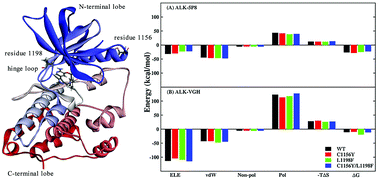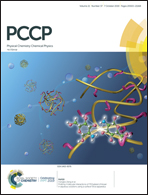Drug-resistance mechanisms of three mutations in anaplastic lymphoma kinase against two inhibitors based on MM/PBSA combined with interaction entropy†
Abstract
As a promising drug target in the treatment of lung cancer, anaplastic lymphoma kinase (ALK) and its mutations have been studied widely through the development of multiple generations of inhibitors. Experiments have found that compared with the wild-type, the L1198F and C1156Y/L1198F mutations resulted in resistance to 5P8 inhibitors, and the C1156Y mutation resulted in resistance to VGH inhibitors. In this study, the newly developed interaction entropy (IE) method combined with the polarized protein-specific charge (PPC) force field was utilized to explore the origin of the resistance mechanism of the ALK mutant system. The calculated binding free energy was consistent with the experimental results. Per-residue binding free energy decomposition showed that the predicted hot-spot residues (LEU1122, LEU/PHE1198, MET1199, GLY1202 and LEU1256) were almost identical across systems. Especially, the GLU1197 residue played an important role in inducing drug-resistance for both inhibitors. The electrostatic interaction of GLU1197, PHE1198 and MET1199 mainly resulted in the resistances of the L1198F and C1156Y/L1198F mutations to 5P8. And the van der Waals interaction energy of LEU1256 residue, and electrostatic energy and entropy change of GLU1197 resulted in the resistances of the C1156Y mutations to VGH. The indicated origins of the drug-resistance in the ALK systems provide a theoretical foundation for the design of potent inhibitors.



 Please wait while we load your content...
Please wait while we load your content...